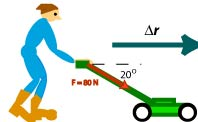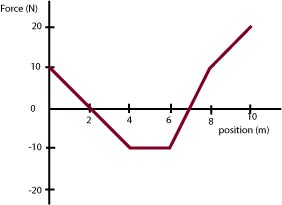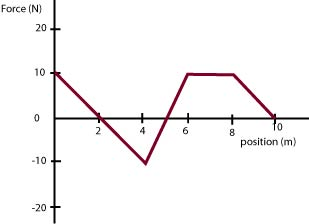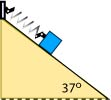Exercises on Work-Energy Theorem
Helena Dedic
Beware: Many of the solutions to these exercises use !
Exercise 1
As a 100 g hockey puck moves across the ice, its speed drops from 20 m/s to 18 m/s.
(a) What is the change in kinetic energy?
(b) What work is done on the puck?
Exercise 2
A person pushes a 10 kg crate 3 m up a 30° incline with a 80-N force parallel to the incline. The frictional force is 22 N. Find the work done
(a) by the person;
(b) by gravity;
(c) by friction;
(d) by the normal force.
(e) What is the change of the kinetic energy of the box?
Exercise 3
A 1.8 kg block is moved at constant speed over a surface for which = 0.25. The displacement is 2 m. It is pulled by a force directed at 45° to the horizontal as shown. Find the work done on the block by
(a) the force ;
(b) by friction;
(c) by gravity.
Exercise 4
What is the work needed to lift 15 kg of water from a well 12 m deep? Assume the water has a constant upward acceleration of 0.7 .
Exercise 5
A man pushes a lawnmower 10 m. There is a resistive force of 10 N acting on the lawnmower as shown in the diagram below.
(a) Find the work done by each force acting on the lawnmower, then the total work done.
(b) Find the net force acting on the lawnmower and then the work done by the net force.

Exercise 6
An incline is a sort of machine because it allows us to use a smaller force to accomplish some task. Does this also mean that we do less work? Does the presence or absence of friction affect your answer?
Exercise 7
Given the following force-position graph for a 200 g particle,
(a) find the work done in going from 2 m to 10 m.
(b) If the particle has a velocity of 2 m/s at 2 m, what is its velocity at 10 m?

Exercise 8
Given the following force-position graph for a 2 kg particle,
(a) find the work done in going from 0 m to 10 m.
(b) If the particle has a velocity of 2 m/s at 0 m, what is its velocity at 10 m?

Exercise 9
A 1-kg mass attached to a spring with = 250 N/m is released from rest. It slides down an incline (The slope of the incline is 37° to the horizontal) until it stops and starts to go up again. The coefficient of kinetic friction is 0.1. Assume that the spring is not initially stretched and that when the mass stops, the extension of the spring m.
(a) Write an expression for the work done by
- the normal force during the slide of the block to a stop;
- the gravitational force during the slide of the block to a stop;
- the friction during the slide of the block to a stop;
- the spring force during the slide of the block to a stop.
(b) What is the net work done on the block?
(c) Determine the extension of the spring when the block stops.
